Factors Influencing Leadership Styles in Workplace Situations Report
VerifiedAdded on 2022/10/15
|9
|2179
|446
Report
AI Summary
This report delves into the multifaceted realm of leadership, commencing with an exploration of diverse leadership styles such as transformational, servant, and autocratic approaches, and how they are influenced by situational factors including environment, team dynamics, and organizational culture. It then proceeds to evaluate the positive and negative effects of these styles on individual and group behavior, considering factors like team readiness and motivation. The report further presents a self-assessment of leadership behaviors, using feedback to analyze personal strengths and weaknesses within the context of a specific leadership model, such as the Blake Mouton Managerial Grid. Finally, it outlines actionable strategies to enhance leadership effectiveness, focusing on improving communication, delegation, and problem-solving skills to foster a more productive and cohesive work environment. The report is supported by references to academic research on leadership theories and practical applications.
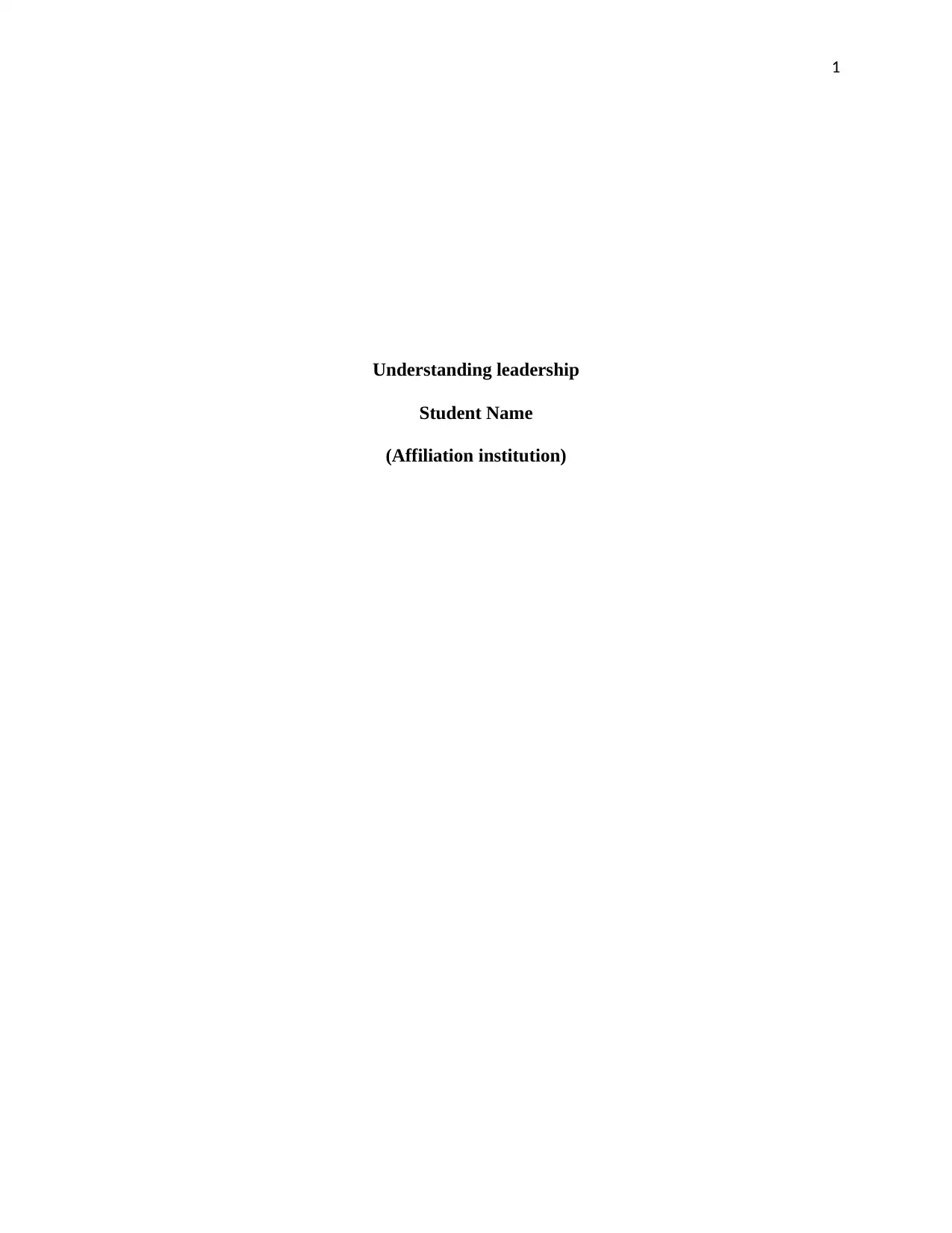
1
Understanding leadership
Student Name
(Affiliation institution)
Understanding leadership
Student Name
(Affiliation institution)
Paraphrase This Document
Need a fresh take? Get an instant paraphrase of this document with our AI Paraphraser
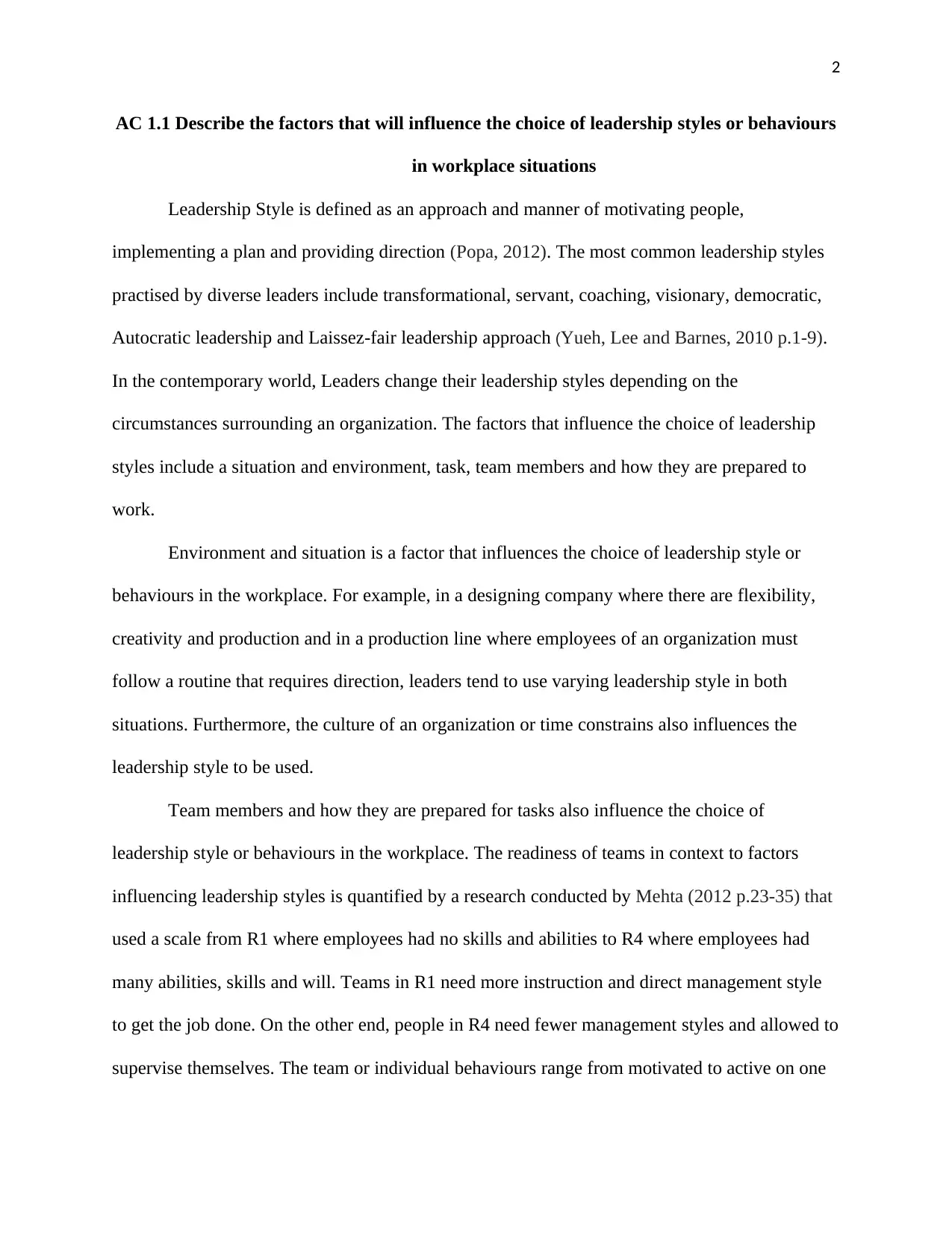
2
AC 1.1 Describe the factors that will influence the choice of leadership styles or behaviours
in workplace situations
Leadership Style is defined as an approach and manner of motivating people,
implementing a plan and providing direction (Popa, 2012). The most common leadership styles
practised by diverse leaders include transformational, servant, coaching, visionary, democratic,
Autocratic leadership and Laissez-fair leadership approach (Yueh, Lee and Barnes, 2010 p.1-9).
In the contemporary world, Leaders change their leadership styles depending on the
circumstances surrounding an organization. The factors that influence the choice of leadership
styles include a situation and environment, task, team members and how they are prepared to
work.
Environment and situation is a factor that influences the choice of leadership style or
behaviours in the workplace. For example, in a designing company where there are flexibility,
creativity and production and in a production line where employees of an organization must
follow a routine that requires direction, leaders tend to use varying leadership style in both
situations. Furthermore, the culture of an organization or time constrains also influences the
leadership style to be used.
Team members and how they are prepared for tasks also influence the choice of
leadership style or behaviours in the workplace. The readiness of teams in context to factors
influencing leadership styles is quantified by a research conducted by Mehta (2012 p.23-35) that
used a scale from R1 where employees had no skills and abilities to R4 where employees had
many abilities, skills and will. Teams in R1 need more instruction and direct management style
to get the job done. On the other end, people in R4 need fewer management styles and allowed to
supervise themselves. The team or individual behaviours range from motivated to active on one
AC 1.1 Describe the factors that will influence the choice of leadership styles or behaviours
in workplace situations
Leadership Style is defined as an approach and manner of motivating people,
implementing a plan and providing direction (Popa, 2012). The most common leadership styles
practised by diverse leaders include transformational, servant, coaching, visionary, democratic,
Autocratic leadership and Laissez-fair leadership approach (Yueh, Lee and Barnes, 2010 p.1-9).
In the contemporary world, Leaders change their leadership styles depending on the
circumstances surrounding an organization. The factors that influence the choice of leadership
styles include a situation and environment, task, team members and how they are prepared to
work.
Environment and situation is a factor that influences the choice of leadership style or
behaviours in the workplace. For example, in a designing company where there are flexibility,
creativity and production and in a production line where employees of an organization must
follow a routine that requires direction, leaders tend to use varying leadership style in both
situations. Furthermore, the culture of an organization or time constrains also influences the
leadership style to be used.
Team members and how they are prepared for tasks also influence the choice of
leadership style or behaviours in the workplace. The readiness of teams in context to factors
influencing leadership styles is quantified by a research conducted by Mehta (2012 p.23-35) that
used a scale from R1 where employees had no skills and abilities to R4 where employees had
many abilities, skills and will. Teams in R1 need more instruction and direct management style
to get the job done. On the other end, people in R4 need fewer management styles and allowed to
supervise themselves. The team or individual behaviours range from motivated to active on one
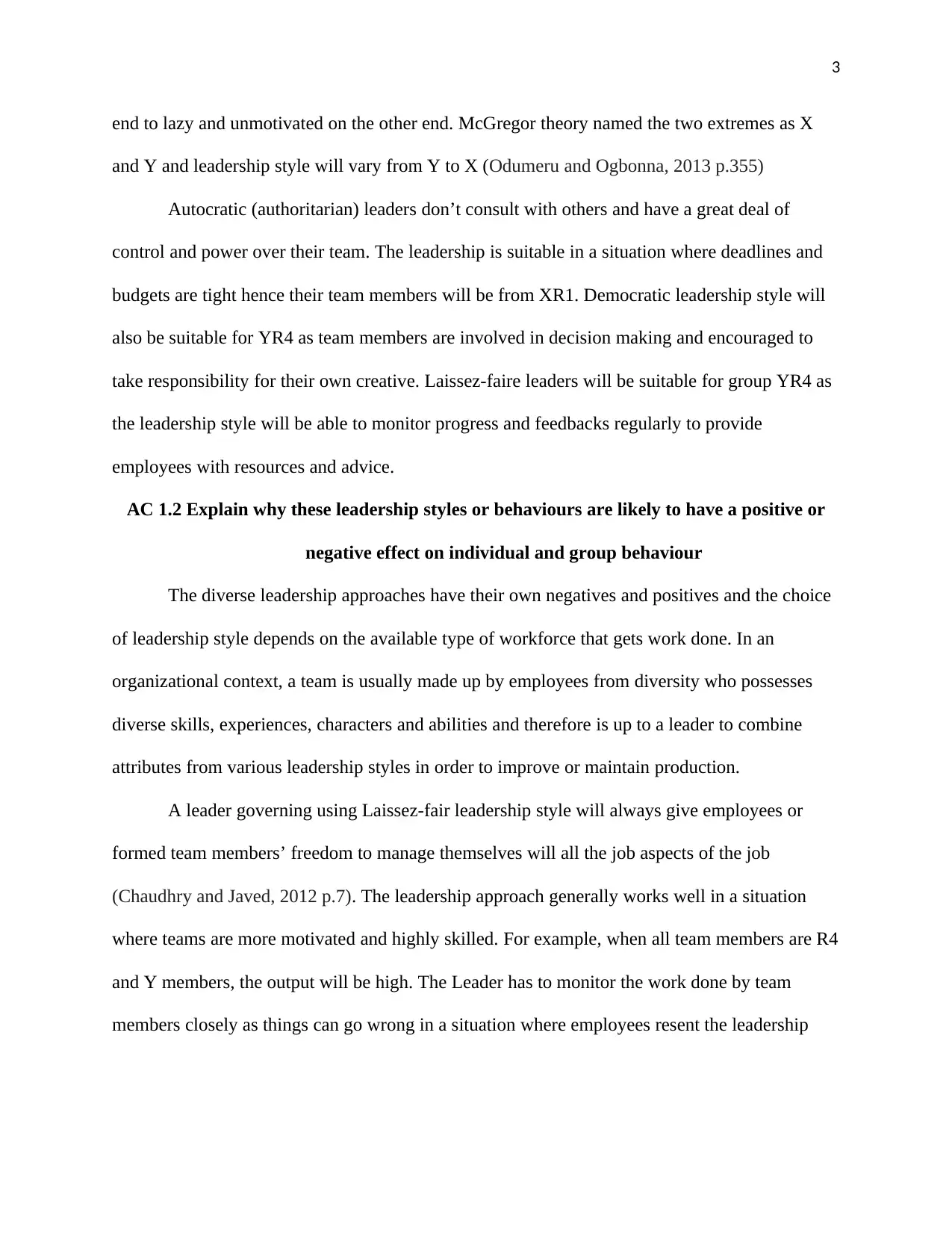
3
end to lazy and unmotivated on the other end. McGregor theory named the two extremes as X
and Y and leadership style will vary from Y to X (Odumeru and Ogbonna, 2013 p.355)
Autocratic (authoritarian) leaders don’t consult with others and have a great deal of
control and power over their team. The leadership is suitable in a situation where deadlines and
budgets are tight hence their team members will be from XR1. Democratic leadership style will
also be suitable for YR4 as team members are involved in decision making and encouraged to
take responsibility for their own creative. Laissez-faire leaders will be suitable for group YR4 as
the leadership style will be able to monitor progress and feedbacks regularly to provide
employees with resources and advice.
AC 1.2 Explain why these leadership styles or behaviours are likely to have a positive or
negative effect on individual and group behaviour
The diverse leadership approaches have their own negatives and positives and the choice
of leadership style depends on the available type of workforce that gets work done. In an
organizational context, a team is usually made up by employees from diversity who possesses
diverse skills, experiences, characters and abilities and therefore is up to a leader to combine
attributes from various leadership styles in order to improve or maintain production.
A leader governing using Laissez-fair leadership style will always give employees or
formed team members’ freedom to manage themselves will all the job aspects of the job
(Chaudhry and Javed, 2012 p.7). The leadership approach generally works well in a situation
where teams are more motivated and highly skilled. For example, when all team members are R4
and Y members, the output will be high. The Leader has to monitor the work done by team
members closely as things can go wrong in a situation where employees resent the leadership
end to lazy and unmotivated on the other end. McGregor theory named the two extremes as X
and Y and leadership style will vary from Y to X (Odumeru and Ogbonna, 2013 p.355)
Autocratic (authoritarian) leaders don’t consult with others and have a great deal of
control and power over their team. The leadership is suitable in a situation where deadlines and
budgets are tight hence their team members will be from XR1. Democratic leadership style will
also be suitable for YR4 as team members are involved in decision making and encouraged to
take responsibility for their own creative. Laissez-faire leaders will be suitable for group YR4 as
the leadership style will be able to monitor progress and feedbacks regularly to provide
employees with resources and advice.
AC 1.2 Explain why these leadership styles or behaviours are likely to have a positive or
negative effect on individual and group behaviour
The diverse leadership approaches have their own negatives and positives and the choice
of leadership style depends on the available type of workforce that gets work done. In an
organizational context, a team is usually made up by employees from diversity who possesses
diverse skills, experiences, characters and abilities and therefore is up to a leader to combine
attributes from various leadership styles in order to improve or maintain production.
A leader governing using Laissez-fair leadership style will always give employees or
formed team members’ freedom to manage themselves will all the job aspects of the job
(Chaudhry and Javed, 2012 p.7). The leadership approach generally works well in a situation
where teams are more motivated and highly skilled. For example, when all team members are R4
and Y members, the output will be high. The Leader has to monitor the work done by team
members closely as things can go wrong in a situation where employees resent the leadership
⊘ This is a preview!⊘
Do you want full access?
Subscribe today to unlock all pages.

Trusted by 1+ million students worldwide
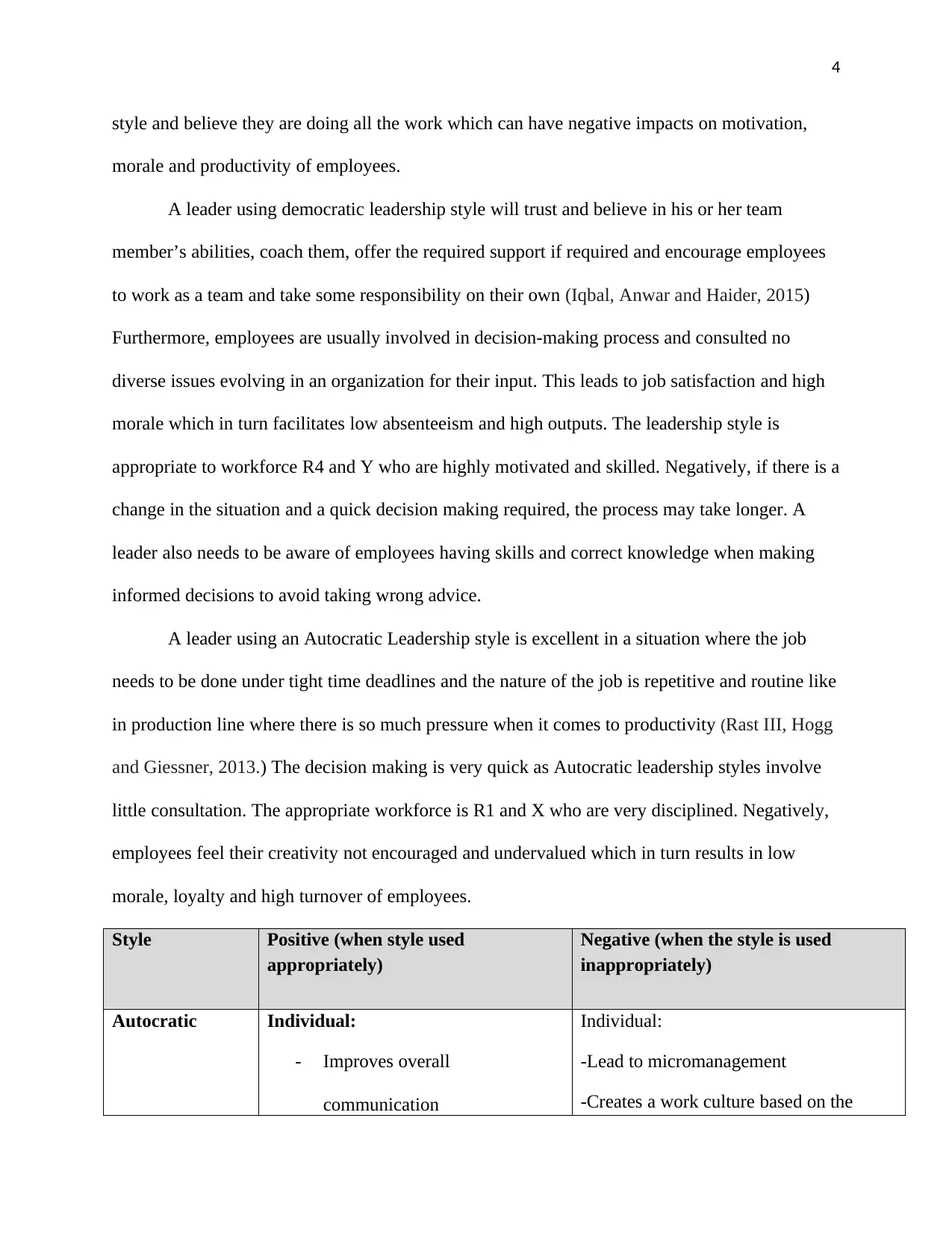
4
style and believe they are doing all the work which can have negative impacts on motivation,
morale and productivity of employees.
A leader using democratic leadership style will trust and believe in his or her team
member’s abilities, coach them, offer the required support if required and encourage employees
to work as a team and take some responsibility on their own (Iqbal, Anwar and Haider, 2015)
Furthermore, employees are usually involved in decision-making process and consulted no
diverse issues evolving in an organization for their input. This leads to job satisfaction and high
morale which in turn facilitates low absenteeism and high outputs. The leadership style is
appropriate to workforce R4 and Y who are highly motivated and skilled. Negatively, if there is a
change in the situation and a quick decision making required, the process may take longer. A
leader also needs to be aware of employees having skills and correct knowledge when making
informed decisions to avoid taking wrong advice.
A leader using an Autocratic Leadership style is excellent in a situation where the job
needs to be done under tight time deadlines and the nature of the job is repetitive and routine like
in production line where there is so much pressure when it comes to productivity (Rast III, Hogg
and Giessner, 2013.) The decision making is very quick as Autocratic leadership styles involve
little consultation. The appropriate workforce is R1 and X who are very disciplined. Negatively,
employees feel their creativity not encouraged and undervalued which in turn results in low
morale, loyalty and high turnover of employees.
Style Positive (when style used
appropriately)
Negative (when the style is used
inappropriately)
Autocratic Individual:
- Improves overall
communication
Individual:
-Lead to micromanagement
-Creates a work culture based on the
style and believe they are doing all the work which can have negative impacts on motivation,
morale and productivity of employees.
A leader using democratic leadership style will trust and believe in his or her team
member’s abilities, coach them, offer the required support if required and encourage employees
to work as a team and take some responsibility on their own (Iqbal, Anwar and Haider, 2015)
Furthermore, employees are usually involved in decision-making process and consulted no
diverse issues evolving in an organization for their input. This leads to job satisfaction and high
morale which in turn facilitates low absenteeism and high outputs. The leadership style is
appropriate to workforce R4 and Y who are highly motivated and skilled. Negatively, if there is a
change in the situation and a quick decision making required, the process may take longer. A
leader also needs to be aware of employees having skills and correct knowledge when making
informed decisions to avoid taking wrong advice.
A leader using an Autocratic Leadership style is excellent in a situation where the job
needs to be done under tight time deadlines and the nature of the job is repetitive and routine like
in production line where there is so much pressure when it comes to productivity (Rast III, Hogg
and Giessner, 2013.) The decision making is very quick as Autocratic leadership styles involve
little consultation. The appropriate workforce is R1 and X who are very disciplined. Negatively,
employees feel their creativity not encouraged and undervalued which in turn results in low
morale, loyalty and high turnover of employees.
Style Positive (when style used
appropriately)
Negative (when the style is used
inappropriately)
Autocratic Individual:
- Improves overall
communication
Individual:
-Lead to micromanagement
-Creates a work culture based on the
Paraphrase This Document
Need a fresh take? Get an instant paraphrase of this document with our AI Paraphraser
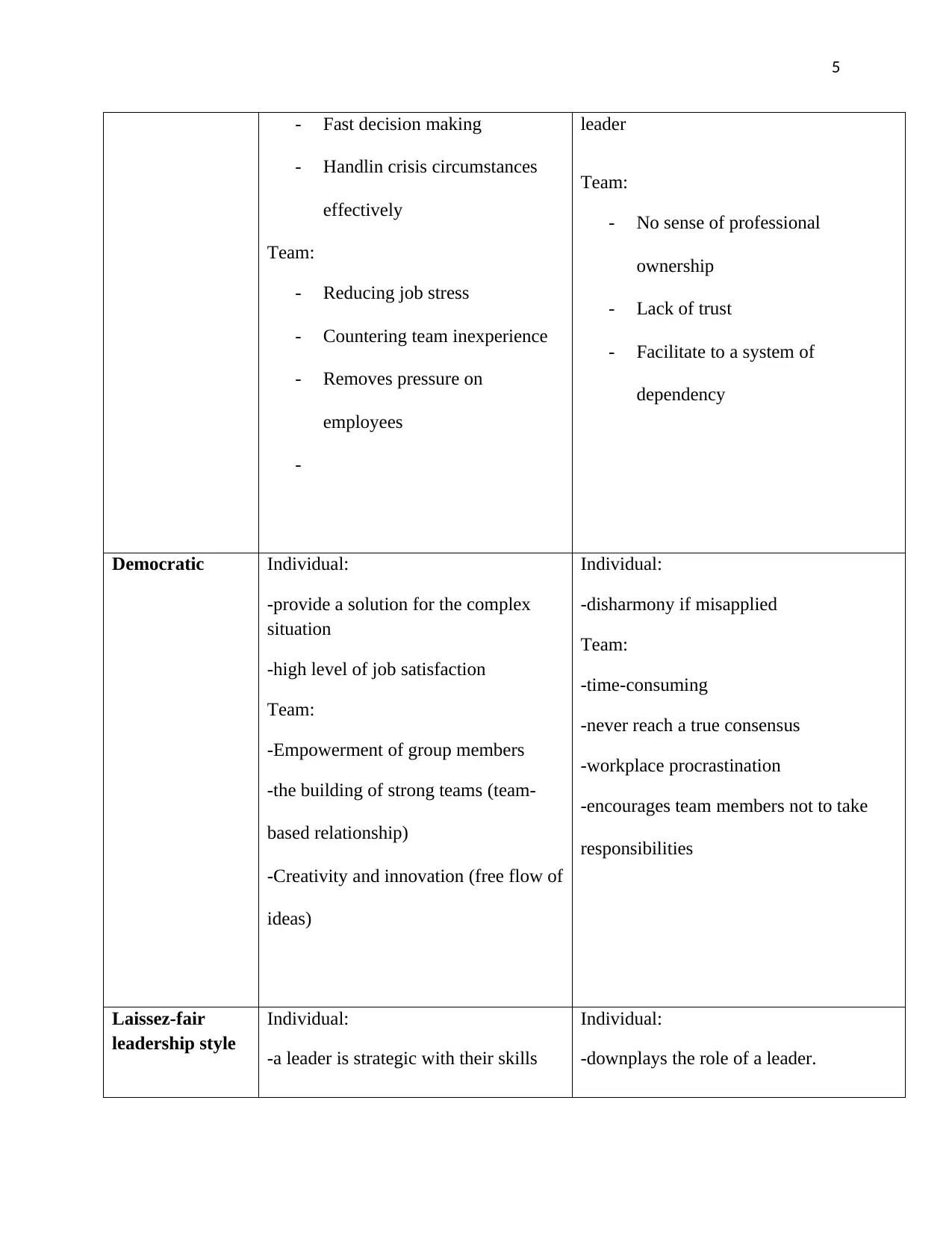
5
- Fast decision making
- Handlin crisis circumstances
effectively
Team:
- Reducing job stress
- Countering team inexperience
- Removes pressure on
employees
-
leader
Team:
- No sense of professional
ownership
- Lack of trust
- Facilitate to a system of
dependency
Democratic Individual:
-provide a solution for the complex
situation
-high level of job satisfaction
Team:
-Empowerment of group members
-the building of strong teams (team-
based relationship)
-Creativity and innovation (free flow of
ideas)
Individual:
-disharmony if misapplied
Team:
-time-consuming
-never reach a true consensus
-workplace procrastination
-encourages team members not to take
responsibilities
Laissez-fair
leadership style
Individual:
-a leader is strategic with their skills
Individual:
-downplays the role of a leader.
- Fast decision making
- Handlin crisis circumstances
effectively
Team:
- Reducing job stress
- Countering team inexperience
- Removes pressure on
employees
-
leader
Team:
- No sense of professional
ownership
- Lack of trust
- Facilitate to a system of
dependency
Democratic Individual:
-provide a solution for the complex
situation
-high level of job satisfaction
Team:
-Empowerment of group members
-the building of strong teams (team-
based relationship)
-Creativity and innovation (free flow of
ideas)
Individual:
-disharmony if misapplied
Team:
-time-consuming
-never reach a true consensus
-workplace procrastination
-encourages team members not to take
responsibilities
Laissez-fair
leadership style
Individual:
-a leader is strategic with their skills
Individual:
-downplays the role of a leader.
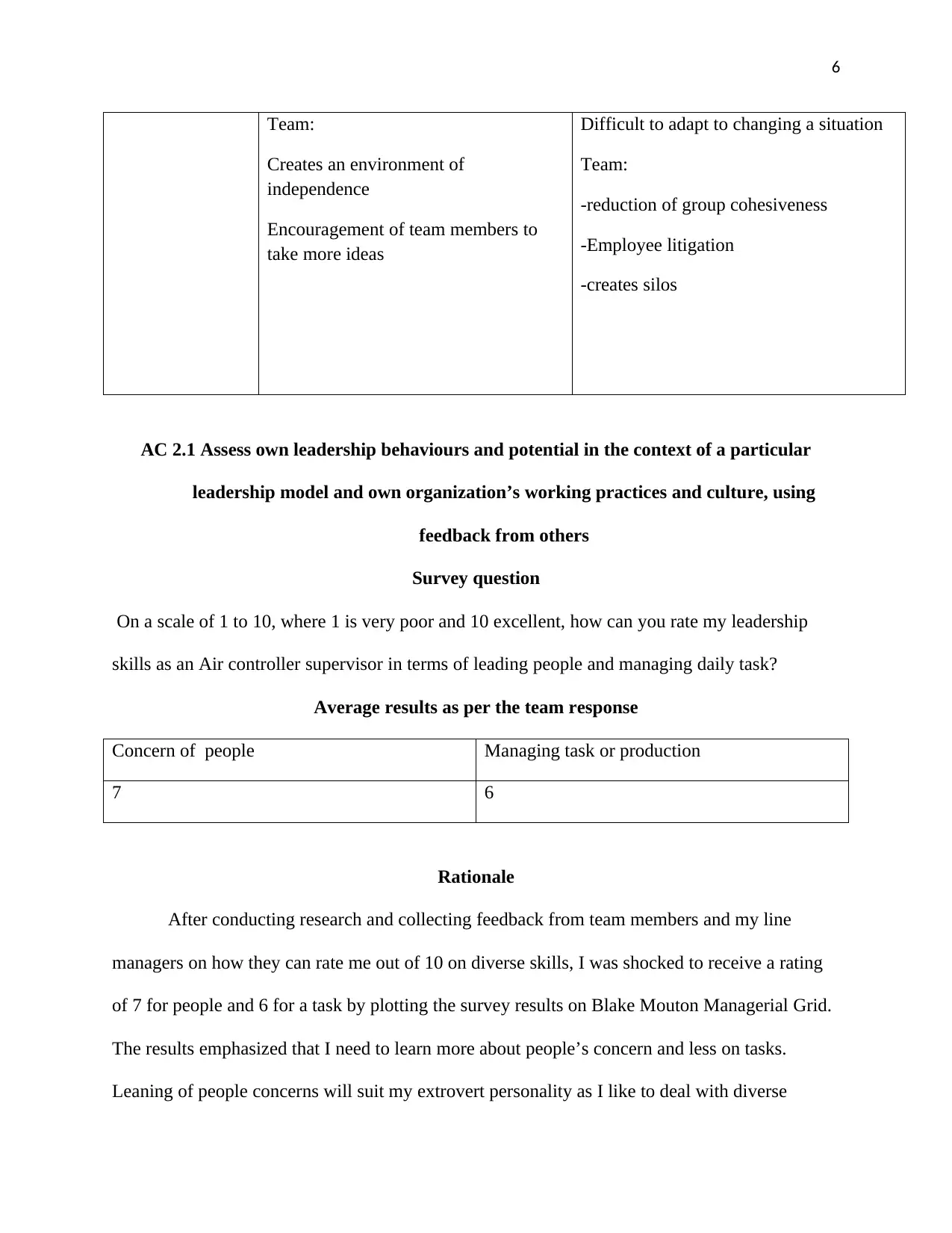
6
Team:
Creates an environment of
independence
Encouragement of team members to
take more ideas
Difficult to adapt to changing a situation
Team:
-reduction of group cohesiveness
-Employee litigation
-creates silos
AC 2.1 Assess own leadership behaviours and potential in the context of a particular
leadership model and own organization’s working practices and culture, using
feedback from others
Survey question
On a scale of 1 to 10, where 1 is very poor and 10 excellent, how can you rate my leadership
skills as an Air controller supervisor in terms of leading people and managing daily task?
Average results as per the team response
Concern of people Managing task or production
7 6
Rationale
After conducting research and collecting feedback from team members and my line
managers on how they can rate me out of 10 on diverse skills, I was shocked to receive a rating
of 7 for people and 6 for a task by plotting the survey results on Blake Mouton Managerial Grid.
The results emphasized that I need to learn more about people’s concern and less on tasks.
Leaning of people concerns will suit my extrovert personality as I like to deal with diverse
Team:
Creates an environment of
independence
Encouragement of team members to
take more ideas
Difficult to adapt to changing a situation
Team:
-reduction of group cohesiveness
-Employee litigation
-creates silos
AC 2.1 Assess own leadership behaviours and potential in the context of a particular
leadership model and own organization’s working practices and culture, using
feedback from others
Survey question
On a scale of 1 to 10, where 1 is very poor and 10 excellent, how can you rate my leadership
skills as an Air controller supervisor in terms of leading people and managing daily task?
Average results as per the team response
Concern of people Managing task or production
7 6
Rationale
After conducting research and collecting feedback from team members and my line
managers on how they can rate me out of 10 on diverse skills, I was shocked to receive a rating
of 7 for people and 6 for a task by plotting the survey results on Blake Mouton Managerial Grid.
The results emphasized that I need to learn more about people’s concern and less on tasks.
Leaning of people concerns will suit my extrovert personality as I like to deal with diverse
⊘ This is a preview!⊘
Do you want full access?
Subscribe today to unlock all pages.

Trusted by 1+ million students worldwide
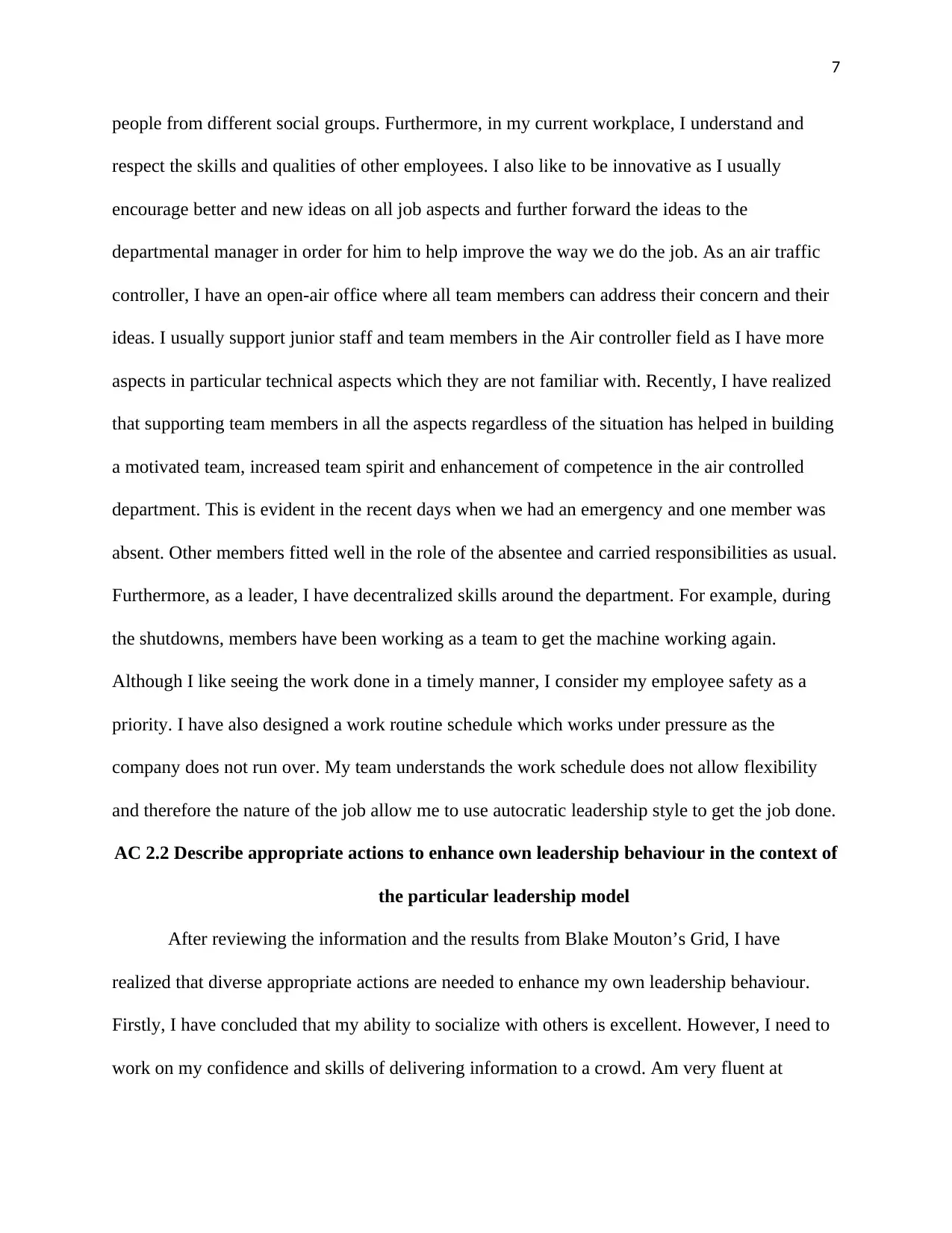
7
people from different social groups. Furthermore, in my current workplace, I understand and
respect the skills and qualities of other employees. I also like to be innovative as I usually
encourage better and new ideas on all job aspects and further forward the ideas to the
departmental manager in order for him to help improve the way we do the job. As an air traffic
controller, I have an open-air office where all team members can address their concern and their
ideas. I usually support junior staff and team members in the Air controller field as I have more
aspects in particular technical aspects which they are not familiar with. Recently, I have realized
that supporting team members in all the aspects regardless of the situation has helped in building
a motivated team, increased team spirit and enhancement of competence in the air controlled
department. This is evident in the recent days when we had an emergency and one member was
absent. Other members fitted well in the role of the absentee and carried responsibilities as usual.
Furthermore, as a leader, I have decentralized skills around the department. For example, during
the shutdowns, members have been working as a team to get the machine working again.
Although I like seeing the work done in a timely manner, I consider my employee safety as a
priority. I have also designed a work routine schedule which works under pressure as the
company does not run over. My team understands the work schedule does not allow flexibility
and therefore the nature of the job allow me to use autocratic leadership style to get the job done.
AC 2.2 Describe appropriate actions to enhance own leadership behaviour in the context of
the particular leadership model
After reviewing the information and the results from Blake Mouton’s Grid, I have
realized that diverse appropriate actions are needed to enhance my own leadership behaviour.
Firstly, I have concluded that my ability to socialize with others is excellent. However, I need to
work on my confidence and skills of delivering information to a crowd. Am very fluent at
people from different social groups. Furthermore, in my current workplace, I understand and
respect the skills and qualities of other employees. I also like to be innovative as I usually
encourage better and new ideas on all job aspects and further forward the ideas to the
departmental manager in order for him to help improve the way we do the job. As an air traffic
controller, I have an open-air office where all team members can address their concern and their
ideas. I usually support junior staff and team members in the Air controller field as I have more
aspects in particular technical aspects which they are not familiar with. Recently, I have realized
that supporting team members in all the aspects regardless of the situation has helped in building
a motivated team, increased team spirit and enhancement of competence in the air controlled
department. This is evident in the recent days when we had an emergency and one member was
absent. Other members fitted well in the role of the absentee and carried responsibilities as usual.
Furthermore, as a leader, I have decentralized skills around the department. For example, during
the shutdowns, members have been working as a team to get the machine working again.
Although I like seeing the work done in a timely manner, I consider my employee safety as a
priority. I have also designed a work routine schedule which works under pressure as the
company does not run over. My team understands the work schedule does not allow flexibility
and therefore the nature of the job allow me to use autocratic leadership style to get the job done.
AC 2.2 Describe appropriate actions to enhance own leadership behaviour in the context of
the particular leadership model
After reviewing the information and the results from Blake Mouton’s Grid, I have
realized that diverse appropriate actions are needed to enhance my own leadership behaviour.
Firstly, I have concluded that my ability to socialize with others is excellent. However, I need to
work on my confidence and skills of delivering information to a crowd. Am very fluent at
Paraphrase This Document
Need a fresh take? Get an instant paraphrase of this document with our AI Paraphraser
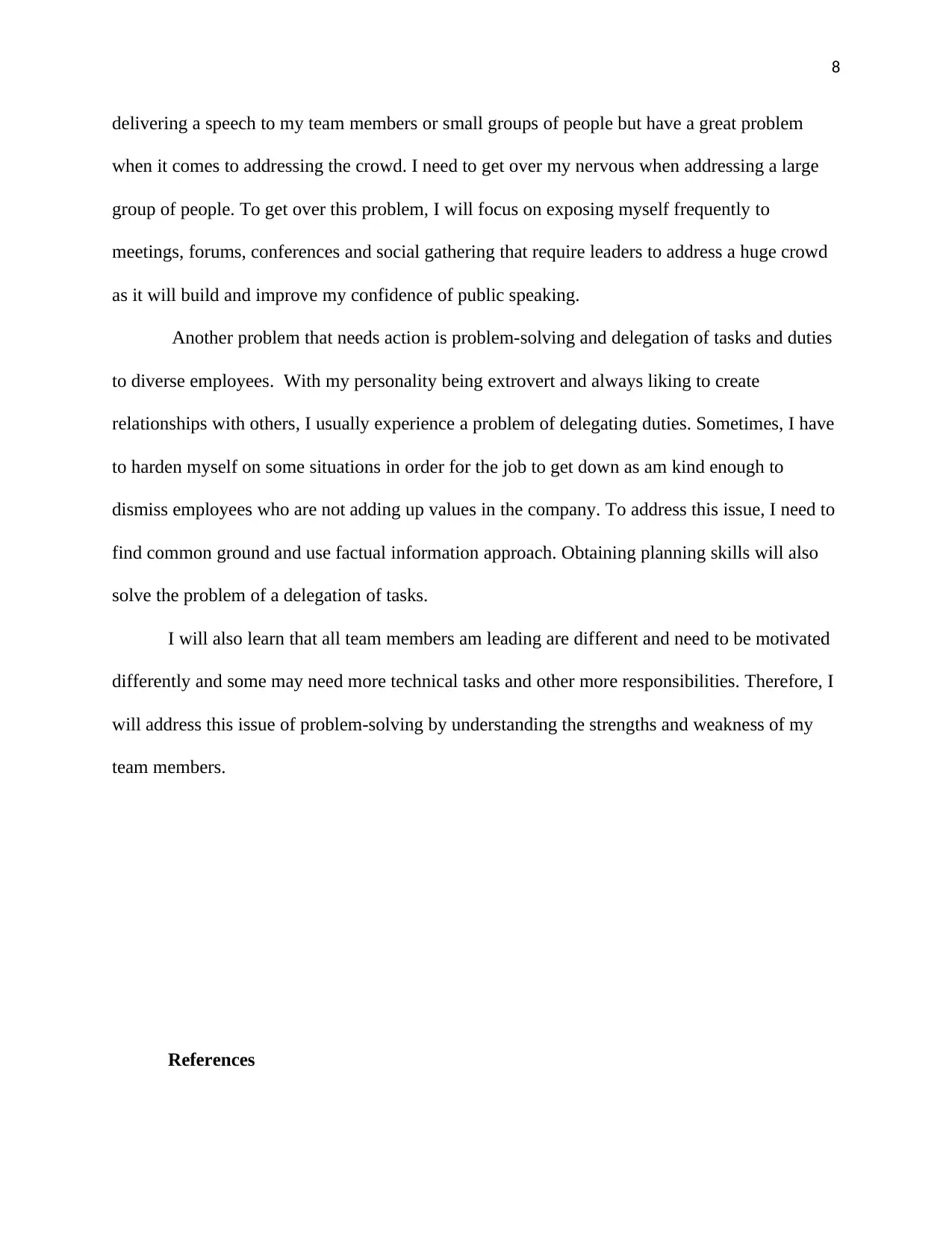
8
delivering a speech to my team members or small groups of people but have a great problem
when it comes to addressing the crowd. I need to get over my nervous when addressing a large
group of people. To get over this problem, I will focus on exposing myself frequently to
meetings, forums, conferences and social gathering that require leaders to address a huge crowd
as it will build and improve my confidence of public speaking.
Another problem that needs action is problem-solving and delegation of tasks and duties
to diverse employees. With my personality being extrovert and always liking to create
relationships with others, I usually experience a problem of delegating duties. Sometimes, I have
to harden myself on some situations in order for the job to get down as am kind enough to
dismiss employees who are not adding up values in the company. To address this issue, I need to
find common ground and use factual information approach. Obtaining planning skills will also
solve the problem of a delegation of tasks.
I will also learn that all team members am leading are different and need to be motivated
differently and some may need more technical tasks and other more responsibilities. Therefore, I
will address this issue of problem-solving by understanding the strengths and weakness of my
team members.
References
delivering a speech to my team members or small groups of people but have a great problem
when it comes to addressing the crowd. I need to get over my nervous when addressing a large
group of people. To get over this problem, I will focus on exposing myself frequently to
meetings, forums, conferences and social gathering that require leaders to address a huge crowd
as it will build and improve my confidence of public speaking.
Another problem that needs action is problem-solving and delegation of tasks and duties
to diverse employees. With my personality being extrovert and always liking to create
relationships with others, I usually experience a problem of delegating duties. Sometimes, I have
to harden myself on some situations in order for the job to get down as am kind enough to
dismiss employees who are not adding up values in the company. To address this issue, I need to
find common ground and use factual information approach. Obtaining planning skills will also
solve the problem of a delegation of tasks.
I will also learn that all team members am leading are different and need to be motivated
differently and some may need more technical tasks and other more responsibilities. Therefore, I
will address this issue of problem-solving by understanding the strengths and weakness of my
team members.
References
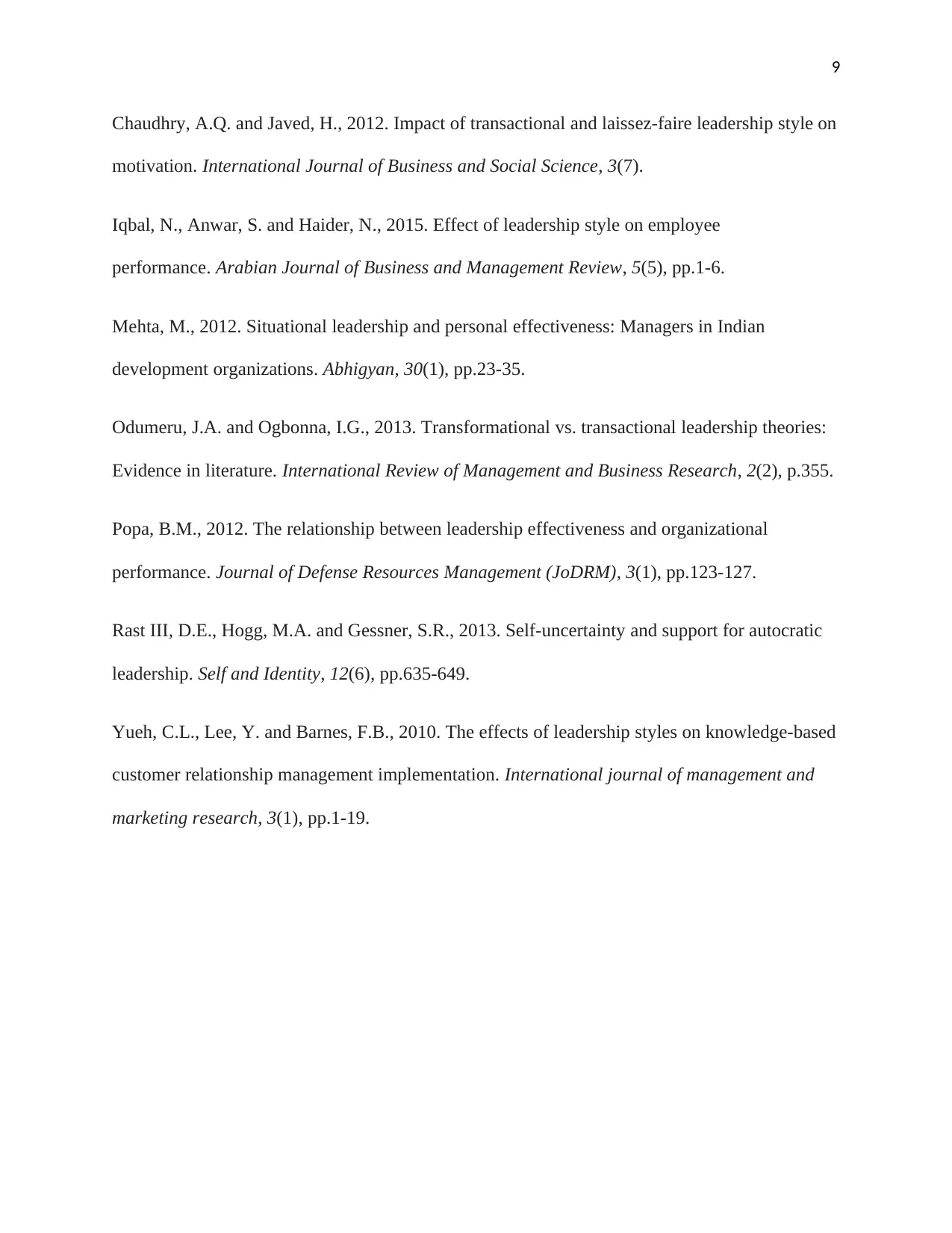
9
Chaudhry, A.Q. and Javed, H., 2012. Impact of transactional and laissez-faire leadership style on
motivation. International Journal of Business and Social Science, 3(7).
Iqbal, N., Anwar, S. and Haider, N., 2015. Effect of leadership style on employee
performance. Arabian Journal of Business and Management Review, 5(5), pp.1-6.
Mehta, M., 2012. Situational leadership and personal effectiveness: Managers in Indian
development organizations. Abhigyan, 30(1), pp.23-35.
Odumeru, J.A. and Ogbonna, I.G., 2013. Transformational vs. transactional leadership theories:
Evidence in literature. International Review of Management and Business Research, 2(2), p.355.
Popa, B.M., 2012. The relationship between leadership effectiveness and organizational
performance. Journal of Defense Resources Management (JoDRM), 3(1), pp.123-127.
Rast III, D.E., Hogg, M.A. and Gessner, S.R., 2013. Self-uncertainty and support for autocratic
leadership. Self and Identity, 12(6), pp.635-649.
Yueh, C.L., Lee, Y. and Barnes, F.B., 2010. The effects of leadership styles on knowledge-based
customer relationship management implementation. International journal of management and
marketing research, 3(1), pp.1-19.
Chaudhry, A.Q. and Javed, H., 2012. Impact of transactional and laissez-faire leadership style on
motivation. International Journal of Business and Social Science, 3(7).
Iqbal, N., Anwar, S. and Haider, N., 2015. Effect of leadership style on employee
performance. Arabian Journal of Business and Management Review, 5(5), pp.1-6.
Mehta, M., 2012. Situational leadership and personal effectiveness: Managers in Indian
development organizations. Abhigyan, 30(1), pp.23-35.
Odumeru, J.A. and Ogbonna, I.G., 2013. Transformational vs. transactional leadership theories:
Evidence in literature. International Review of Management and Business Research, 2(2), p.355.
Popa, B.M., 2012. The relationship between leadership effectiveness and organizational
performance. Journal of Defense Resources Management (JoDRM), 3(1), pp.123-127.
Rast III, D.E., Hogg, M.A. and Gessner, S.R., 2013. Self-uncertainty and support for autocratic
leadership. Self and Identity, 12(6), pp.635-649.
Yueh, C.L., Lee, Y. and Barnes, F.B., 2010. The effects of leadership styles on knowledge-based
customer relationship management implementation. International journal of management and
marketing research, 3(1), pp.1-19.
⊘ This is a preview!⊘
Do you want full access?
Subscribe today to unlock all pages.

Trusted by 1+ million students worldwide
1 out of 9
Related Documents
Your All-in-One AI-Powered Toolkit for Academic Success.
+13062052269
info@desklib.com
Available 24*7 on WhatsApp / Email
![[object Object]](/_next/static/media/star-bottom.7253800d.svg)
Unlock your academic potential
Copyright © 2020–2025 A2Z Services. All Rights Reserved. Developed and managed by ZUCOL.




